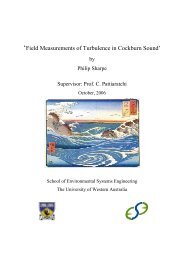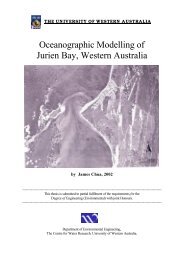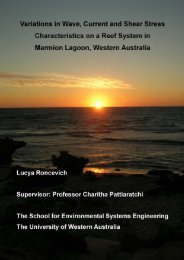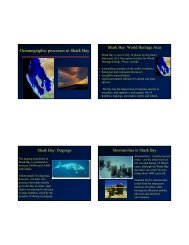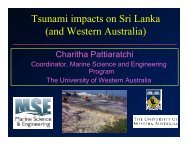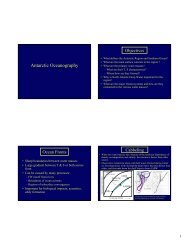Directional Waves in the Nearshore Coastal Region of Perth ...
Directional Waves in the Nearshore Coastal Region of Perth ...
Directional Waves in the Nearshore Coastal Region of Perth ...
You also want an ePaper? Increase the reach of your titles
YUMPU automatically turns print PDFs into web optimized ePapers that Google loves.
<strong>Directional</strong> waves <strong>in</strong> <strong>the</strong> nearshore coastal region <strong>of</strong> <strong>Perth</strong>, Western AustraliaHuey Jean Taneng<strong>in</strong>eer<strong>in</strong>g practice <strong>in</strong> <strong>the</strong> plann<strong>in</strong>g and design<strong>in</strong>g <strong>of</strong> many harbour and coastal projects(Goda 1995).The aim <strong>of</strong> <strong>the</strong> present study is to carry out an analysis <strong>of</strong> <strong>the</strong> nearshore directional waves <strong>in</strong><strong>the</strong> <strong>Perth</strong> coastal region. <strong>Perth</strong> is <strong>the</strong> capital city <strong>of</strong> Western Australia, and is located on <strong>the</strong>south-west coast <strong>of</strong> <strong>the</strong> Australian cont<strong>in</strong>ent. Beaches along <strong>the</strong> coastl<strong>in</strong>e <strong>of</strong> <strong>Perth</strong> exhibit anapparent seasonality <strong>in</strong> beach morphology, however not all beaches are characterised by <strong>the</strong>same seasonal cycle (Massel<strong>in</strong>k & Pattiaratchi 2001). Some <strong>of</strong> <strong>the</strong> <strong>Perth</strong> beaches becomewider dur<strong>in</strong>g summer (i.e. accretion) and narrower dur<strong>in</strong>g w<strong>in</strong>ter (i.e. erosion) whereas o<strong>the</strong>rsexperience summer erosion and w<strong>in</strong>ter accretion (Massel<strong>in</strong>k & Pattiaratchi 2001). It isgenerally accepted that seasonal beach cycles are due to seasonal variations <strong>in</strong> <strong>the</strong> <strong>in</strong>cidentwave energy conditions; however <strong>the</strong> study by Massel<strong>in</strong>k & Pattiaratchi (2001) demonstratedthat <strong>the</strong> seasonal changes on most beaches along <strong>the</strong> <strong>Perth</strong> coasts are better expla<strong>in</strong>ed by <strong>the</strong>seasonal reversal <strong>in</strong> <strong>the</strong> littoral drift direction. The direction <strong>of</strong> littoral drift depends largelyupon <strong>the</strong> direction <strong>of</strong> <strong>the</strong> waves <strong>in</strong>cident on <strong>the</strong> beaches (i.e. nearshore waves), which is, <strong>in</strong>turn, affected by <strong>the</strong> direction <strong>of</strong> w<strong>in</strong>d. Dur<strong>in</strong>g summer, northward sediment transport prevailsdue to sea breeze activity blow<strong>in</strong>g <strong>in</strong> a predom<strong>in</strong>antly south-southwest direction; howeverdur<strong>in</strong>g w<strong>in</strong>ter, <strong>the</strong> longshore sediment transport is towards <strong>the</strong> south due to southwardflow<strong>in</strong>gcurrents generated by northwesterly storms (Massel<strong>in</strong>k & Pattiaratchi 2001). Due to alack <strong>of</strong> nearshore directional wave data at <strong>the</strong> time <strong>of</strong> <strong>the</strong> study by Massel<strong>in</strong>k & Pattiaratchi(2001), conclusions could only be drawn on <strong>the</strong> basis <strong>of</strong> <strong>the</strong> w<strong>in</strong>d speed and direction. Thema<strong>in</strong> objective <strong>of</strong> <strong>the</strong> analysis is to quantify <strong>the</strong> directional wave response to changes <strong>in</strong>meteorological conditions (specifically storm and sea breeze events). The <strong>in</strong>formation fromthis study can <strong>the</strong>n be applied to <strong>the</strong> f<strong>in</strong>d<strong>in</strong>gs by Massel<strong>in</strong>k & Pattiaratchi (2001). This is <strong>the</strong>first time a study <strong>of</strong> nearshore directional waves is done for <strong>the</strong> <strong>Perth</strong> coastal region..2 Introduction



